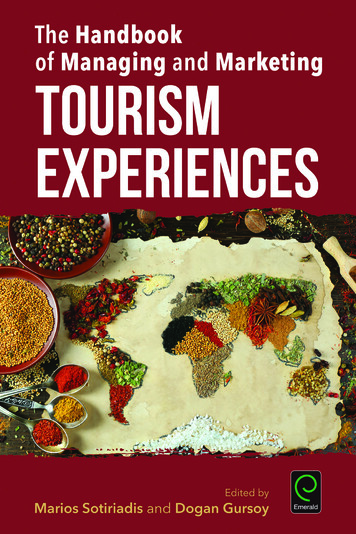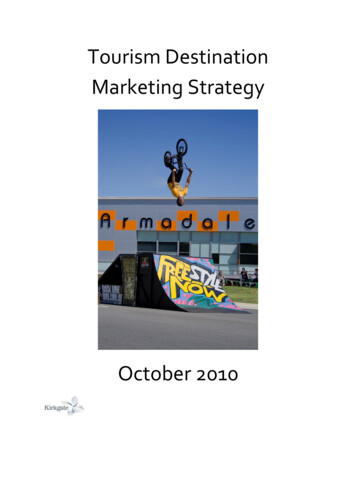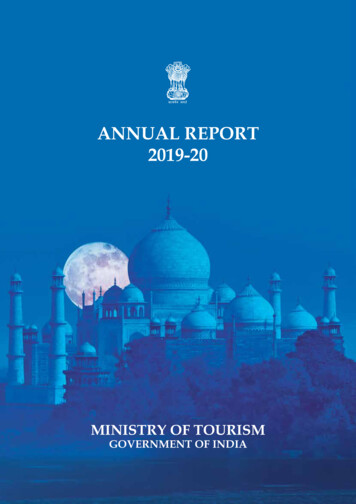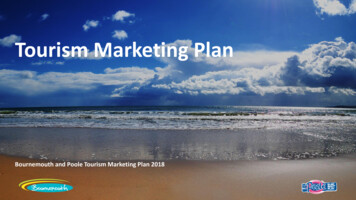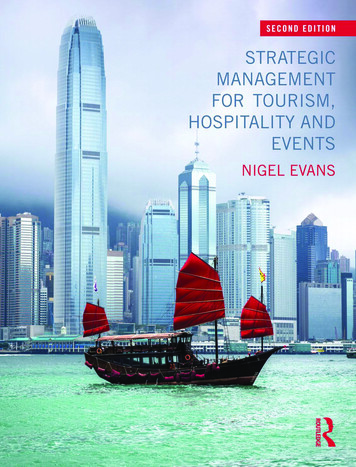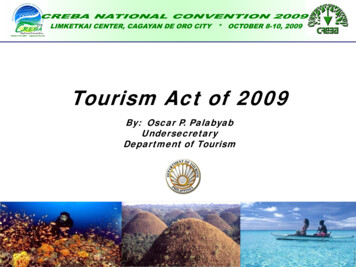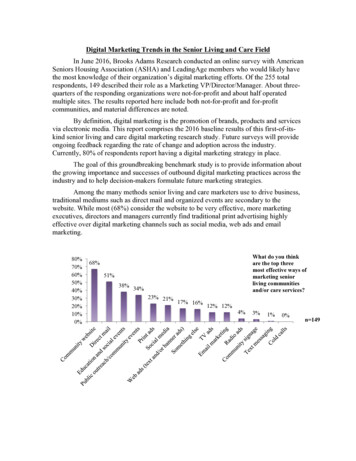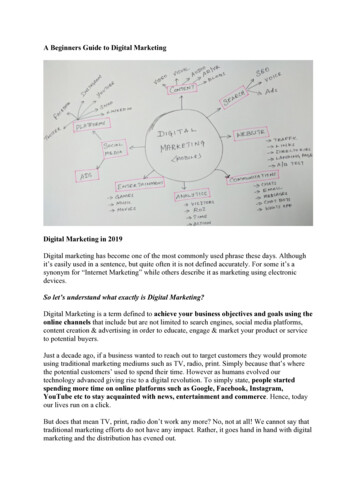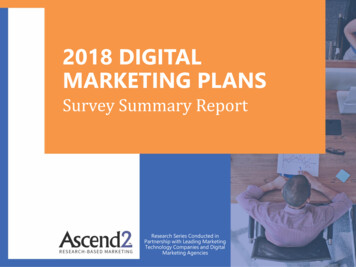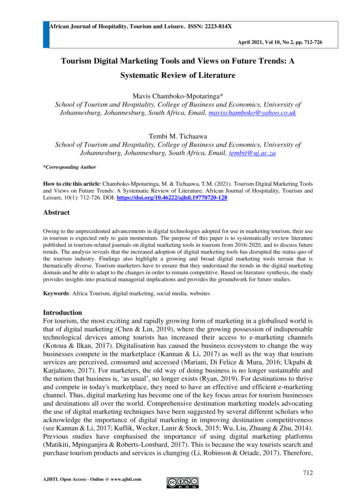
Transcription
African Journal of Hospitality, Tourism and Leisure. ISSN: 2223-814XApril 2021, Vol 10, No 2, pp. 712-726Tourism Digital Marketing Tools and Views on Future Trends: ASystematic Review of LiteratureMavis Chamboko-Mpotaringa*School of Tourism and Hospitality, College of Business and Economics, University ofJohannesburg, Johannesburg, South Africa, Email, mavischamboko@yahoo.co.ukTembi M. TichaawaSchool of Tourism and Hospitality, College of Business and Economics, University ofJohannesburg, Johannesburg, South Africa, Email, tembit@uj.ac.za*Corresponding AuthorHow to cite this article: Chamboko-Mpotaringa, M. & Tichaawa, T.M. (2021). Tourism Digital Marketing Toolsand Views on Future Trends: A Systematic Review of Literature. African Journal of Hospitality, Tourism andLeisure, 10(1): 712-726. DOI: tOwing to the unprecedented advancements in digital technologies adopted for use in marketing tourism, their usein tourism is expected only to gain momentum. The purpose of this paper is to systematically review literaturepublished in tourism-related journals on digital marketing tools in tourism from 2016-2020, and to discuss futuretrends. The analysis reveals that the increased adoption of digital marketing tools has disrupted the status quo ofthe tourism industry. Findings also highlight a growing and broad digital marketing tools terrain that isthematically diverse. Tourism marketers have to ensure that they understand the trends in the digital marketingdomain and be able to adapt to the changes in order to remain competitive. Based on literature synthesis, the studyprovides insights into practical managerial implications and provides the groundwork for future studies.Keywords: Africa Tourism, digital marketing, social media, websitesIntroductionFor tourism, the most exciting and rapidly growing form of marketing in a globalised world isthat of digital marketing (Chen & Lin, 2019), where the growing possession of indispensabletechnological devices among tourists has increased their access to e-marketing channels(Kotoua & Ilkan, 2017). Digitalisation has caused the business ecosystem to change the waybusinesses compete in the marketplace (Kannan & Li, 2017) as well as the way that tourismservices are perceived, consumed and accessed (Mariani, Di Felice & Mura, 2016; Ukpabi &Karjaluoto, 2017). For marketers, the old way of doing business is no longer sustainable andthe notion that business is, ‘as usual’, no longer exists (Ryan, 2019). For destinations to thriveand compete in today's marketplace, they need to have an effective and efficient e-marketingchannel. Thus, digital marketing has become one of the key focus areas for tourism businessesand destinations all over the world. Comprehensive destination marketing models advocatingthe use of digital marketing techniques have been suggested by several different scholars whoacknowledge the importance of digital marketing in improving destination competitiveness(see Kannan & Li, 2017; Kuflik, Wecker, Lanir & Stock, 2015; Wu, Liu, Zhuang & Zhu, 2014).Previous studies have emphasised the importance of using digital marketing platforms(Matikiti, Mpinganjira & Roberts-Lombard, 2017). This is because the way tourists search andpurchase tourism products and services is changing (Li, Robinson & Oriade, 2017). Therefore,712AJHTL Open Access - Online @ www.ajhtl.com
African Journal of Hospitality, Tourism and Leisure, Volume X (X) - (2020) ISSN: 2223-814XCopyright: 2020 AJHTL /Author(s) Open Access – Online @ www.ajhtl.comfor destinations, using the most effective digital marketing tools is crucial as it provides themwith a significant advantage. It would be valuable for academics and the industry to have aninsight into the kinds of tourism digital marketing tools that are influencing tourism marketing.The main aim of this review is thus to critically review literature on digital marketing withinthe tourism context. To achieve this aim, the three objectives of this review are as follows: toexplore the different digital marketing tools in the tourism industry; to analyse the digitalmarketing trends affecting tourism, and to provide views on future trends.Methodology reviewKnowledge production in research is accelerating, such that existing knowledge acts as abuilding block of academic research activities (Snyder, 2019). Thus, to achieve the objectivesof this study, a systematic literature review method was adopted. A systematic literature reviewuses systematic and transparent methods to identify, select and evaluate relevant literaturepublished during a specific period and on a specific topic (Opute, Irene & Iwu, 2020). Becauseof its ability to provide evidence of effectiveness, the systematic review method can informpolicy and practice (Snyder, 2019). A review protocol was formulated as a guide for theliterature search (Pickering & Byrne, 2014), using ‘digital marketing and ‘e-marketing’ assearch terms. The term “tourism” was also used in the search, from the title, abstract, keywordsor within the text, in order to present the extant state of digital marketing-related discussionwithin tourism. Using the aforementioned search terms, a literature search was then conductedfrom the seven most visited journal databases of scientific papers related to tourism. Thedatabases were Science Direct (Elsevier), Emerald Insight, EBSCO Host (Hospitality andTourism Complete), Scopus, Web of Science, ProQuest and Sage publications. All sevendatabases were utilized to ensure comprehensiveness and to avoid omission of relevantresearch articles. The databases allow local studies to be included since they encompass globalarticles. Only peer-reviewed articles published in English that contained original research wereconsidered to enable effective synthesis and to safeguard quality. In order to identify researchtrends, the review covered a period of five years: 2016 to 2020. Searches in Science Direct,Scopus and Sage publications were limited to the social sciences discipline. From thedatabases, only journals which aim to promote dissemination of research related to tourismwere selected.In terms of applying the exclusion criteria, the review excluded the following: articlesthat were not full papers, work in progress, papers that were not peer-reviewed, editor notes,prefaces, research notes, industry articles, internet publications, conference proceedings, booksand chapters. Literature that was outside the cover period (2016-2020) was also excluded.Additionally, literature that was not written in English and duplicate studies using footnoteswere eliminated. In January 2021, a literature search identified sixty-three journals focusing ondisseminating tourism-related research. Of the 842 peer-reviewed articles that were foundwithin this journal search, 594 articles met the established criteria and 247 duplicate articleswere eliminated. For paper selection, a four-staged filter process was applied (identification,screening, eligibility and inclusion). Searching across databases resulted in a comprehensivelist of articles being identified. Seven additional records identified from other sources (like thereference list of the identified articles) which met the requirements of the search query stringwere also added. The papers’ abstracts, the authors’ keywords and the titles were then screenedand the duplicates were removed. Fifty-four articles eligible for full paper assessment wereconsequently found. The papers were then coded to identify the digital marketing toolsdiscussed.713
African Journal of Hospitality, Tourism and Leisure, Volume X (X) - (2020) ISSN: 2223-814XCopyright: 2020 AJHTL /Author(s) Open Access – Online @ www.ajhtl.comResultsThe review shows that from the articles that were found eligible for full paper assessment, 19%were published in 2016, 15% in 2017, 11% in 2018, 20% in 2019 and 35% in 2020. The topfive publishing journals were found to be Tourism Management (22%), Journal of DestinationMarketing and Management (20%) Annals of Tourism Research (11%) Journal of Hospitalityand Tourism Management (7%) and Tourism Management Perspectives (7%). Key findingssuch as varying definitions for digital marketing and popular tourism digital marketing tools(websites, social media, chatbots, Augmented Reality (AR), Virtual Reality (VR) a mobiletravel applications) emerged. Additionally, differences were also found in the digital marketingtrends affecting tourism discussed as well as the views on the future . These findings arediscussed in the next section.DiscussionTourism marketing is shifting from the use of traditional marketing tools to the adoption andincorporation of digital technologies. Findings show an increasing interest in research in digitalmarketing in tourism. Research interest in tourism digital marketing has significantly increasedover the review period from 19% in 2016 to 35% in 2020. Although research output slightlydecreased in the years between (in 2017 and 2018), there was a significant increase in 2020.The greatest interest in tourism digital marketing research was registered in TourismManagement (22%) and Journal of Destination Marketing and Management (20%), with theinterest falling to as low as 2% in other journals. This result highlights the need for othertourism journals to disseminate more research related to digital marketing. The use of digitalmedia in marketing is no longer a new phenomenon, yet researchers lack consensus on a singledefinition of digital marketing. Academics and scholars make use of a range of terms, such ase-marketing, online marketing, web marketing and internet marketing, to offer an explanationfor the concept of digital marketing (Chaffey & Ellis-Chadwick, 2019; Haneef, 2017). Thefollowing key definitions for digital marketing have been extracted and deduced (Table 1).Table 1: Definitions of digital marketingAuthor (s)(Kotoua & Ilkan, 2017)(Haneef, 2017:30)(Lagiewski & Kesgin, 2017)(Li et al., 2017)(Abou-Shouk, 2018)(Cranmer, tom Dieck, &Fountoulaki, 2020)(Labanauskaitė, Fiore and Stašys,2020:3)(Srinivaasan & Kabia, 2020)MeaningThe use of the internet (websites, social media and electronic word of mouth) inproviding different types of tools and marketing channels to facilitate communicationand engagement with and of potential tourists and their information needs. The internetis used to market tourism products and services to online destination markets.“Digital Marketing is defined as describing the process of using digital media, as wellas information and communications technologies, to deliver marketing messages.”The use of digital technologies such as the internet, mobile devices and globalpositioning systems as a key instrument in marketing visitor attractions.Use of technology in marketingThe use of online portals in destination marketing and marketing tourist services andproducts, to improve marketing efforts and increase sales and profits.Embedding of technologies into marketing activities“An integrated process by which an enterprise sends a marketing message to a targetsegment by using the Internet and other digital-based marketing tools.”Using mobile technology (smartphones) for destination promotion in travel andtourism industry by changing conventional methods of seeking information, selectingand exploring destinations and post-tour management to transform travel experiences.Although scholars differ in their specific understanding and use of the term digital marketing,illustrated by Table 1, the authors agree that digital marketing relies on internet technology. Inaddition, in defining digital marketing, authors consistently emphasized the use of digitaltechnologies as the key characteristic of digital marketing.714
African Journal of Hospitality, Tourism and Leisure, Volume X (X) - (2020) ISSN: 2223-814XCopyright: 2020 AJHTL /Author(s) Open Access – Online @ www.ajhtl.comHaving highlighted the meanings of digital marketing from the perspectives of differentscholars, this study considers a definition for digital marketing as a strategy that uses internettechnologies to connect with potential and existing customers to inform, create awareness,increase sales and to make profits. The terms “customers”, “tourists” and “travellers” are usedinterchangeably in this paper.Digital marketing tools for the tourism industryDigital technologies have revolutionised the rules of marketing (Magano & Cunha, 2020) andtransformed how tourist destinations are promoted online (Jiménez-Barreto, Rubio, Campo &Molinillo, 2020). Careful selection of digital marketing tools enhance the organisations’marketing efforts and reduce marketing costs (Angeloni & Rossi, 2020; Cranmer et al., 2020).With the tourism industry being characterised by a different range of online channels, thechallenge lies with tourism marketers to be cognizant of how tourists access information(Almeida-Santana & Moreno-Gil, 2017) and to find effective marketing tools and strategiesthat contribute to the maximisation of profits (Angeloni & Rossi, 2020). Traditionally, thedigital marketing landscape was simple: platforms were maintained by businesses with anexclusive focus on commercial interest whereas now, new sites have evolved with differentfunctions (Bronner & de Hoog, 2016) such that the effective use of digital marketing toolshinges on understanding the digital marketing tools within the tourism context. Magano andCunha (2020) support the notion that understanding digital marketing and harnessing the powerof digital marketing tools is crucial to achieving success in the tourism industry. Based on this,the following section will discuss digital marketing tools that are effecting the tourism industry.WebsitesWebsites are considered an organisation’s place of business and the cornerstone of theorganisation’s marketing actions occur on the internet (Digiorgio, 2016). Websites areperceived as trustworthy and credible digital sources of information when they have a highdegree of institutional control over the content posted (Jiménez-Barreto et al., 2020). Websitecontent should be target-oriented, relevant, comprehensive and should be updated regularly(Labanauskaitė et al., 2020). Websites aim to engage directly with customers by maintainingcommunicative exchanges, thereby eliminating the middlemen (de Rosa, Bocci & Dryjanska,2019), and creating customer loyalty towards the brand. Tourists use search engines in the earlyphase of the search in order to obtain travel related information about destinations(Labanauskaitė et al., 2020). Afterwards, tourists turn to the destinations’ websites (Angeloni& Rossi, 2020). Using search engine optimisation - the use of search techniques (such as usingkeywords) to increase traffic - websites can gain better visibility and boosts their sales(Digiorgio, 2016; Haneef, 2017; Labanauskaitė et al., 2020).Social mediaSocial media is a digital marketing tool that is frequently used by tourists as a source ofinformation as well as engagement (Barcelos, Dantas & Sénécal, 2019; Villamediana, Küster& Vila, 2019; Molina, Gómez, Lyon, Aranda & Loibl, 2020). Social media allows users toform virtual communities (Mariani et al., 2016; Molina et al., 2020) and plays an importantrole in influencing decision making when people publicly share their travel experiences(Magano & Cunha, 2020; Perakakis, Trihas, Venitourakis, Mastorakis & Kopanakis, 2016).Social media is an active social platform with many potential customers (Leung, Sun & Bai,2019). The growth of social media has been triggered by people’s need for social connectionsand for interpersonal interactions (Mkono, 2016). The ability for tourists to instantly share,715
African Journal of Hospitality, Tourism and Leisure, Volume X (X) - (2020) ISSN: 2223-814XCopyright: 2020 AJHTL /Author(s) Open Access – Online @ www.ajhtl.comfollow, like, rate and discuss various types of content helps to keep friends and family up todate about ongoing (travel) experiences (Jansson, 2018; Srinivaasan & Kabia, 2020;Vassiliadis & Belenioti, 2017). In addition, social media postings appeal to the emotional needsof potential customers (Molina et al., 2020). Social activities (such as real-time texting andvideo sharing) facilitate online social contact among people and peer-to-peer communication(Molina et al., 2020). Social media also allows tourists to post online reviews of destinations.Online reviews have gained popularity as an important source of information and an influencerof consumer decision-making (An, Ma, Du, Xiang & Fan, 2020; Tran, 2020). The use ofemoticons (graphic demonstrations of facial expressions) when reviewing destinations hasbecome a common and convenient tool for online customers to better express their ideas orfeelings (Huang, Chang, Bilgihan & Okumus, 2020). More than eighty-five percent oftravellers read online reviews during their pre-trip stage (Huang et al., 2020). This means thatthe majority of customers rely on the opinions of others to make their travel decisions (Tran,2020). From a marketers’ perspective, social media is an important communication andengagement platform (Mariani et al., 2016; Mariani, Mura & Di Felice, 2018). For example,Facebook enables businesses to create pages which potential customers can “like” in order forthem to access and stay up to date with new content as well as to directly interact with thebusiness (Perakakis et al., 2016). This interaction feature allows administrators to understandhow customers engage with the business page (Perakakis et al., 2016). Furthermore,administrators can host events, competitions and post stories, photos and videos (Dolan &Goodman, 2017) in order to promote discussions for the followers of the business page(Vassiliadis & Belenioti, 2017).ChatbotsTechnology has fuelled tourists’ demand for instant gratification (Buhalis & Sinarta, 2019),such that tourists need to interact with businesses that respond immediately and around theclock. Traditional face-to-face service agents have been successful because of their ability tosolve customer problems with honesty and friendliness and to foster an authentic customerrelationships. However, their roles have evolved as organisations move to the online domainin order to better connect with customers in the digital age. Destinations have integratedtechnology into customers' frontline experiences by using chatbots (Park, 2020). Chatbots aremachine conversation systems developed to evoke humanlike interactions (Leung & Wen,2020) and can be considered virtual service agents or “e-service agents” (Tussyadiah, 2020).The infusion of chatbots into the service experiences by tourism organisations is an essentialattribute that enhances customer satisfaction (Park, 2020; Tussyadiah, 2020). Chatbots areprogrammed with selected skills to help customers find restaurants, make hotel reservationsand purchase goods (Leung & Wen, 2020). Chatbots provide reliable information and real-timeinteraction (Tussyadiah, 2020). Since tourism involves the movement of people, with sometravelling to regions that make use of different languages from their home region, Tussyadiah(2020) points out that the use of chatbots substantially alleviates language barriers. Theintegration of chatbots into pre-existing digital marketing tools like websites provides apromising area of growth for businesses (Leung & Wen, 2020).Augmented Reality (AR) and Virtual Reality (VR)Despite considerable research devotion, AR and VR are still in their embryonic stage in tourism(Cranmer et al., 2020; Wei, Qi & Zhang, 2019). That said, their popularity within the tourismindustry, and the academic spheres, are rapidly on the rise (He, Wu & Li, 2018). AR denotesthe adding of digital information to the real environment (Park & Stangl, 2020) therebyenabling consumers to view the real world in front of them, with the addition of a superimposed716
African Journal of Hospitality, Tourism and Leisure, Volume X (X) - (2020) ISSN: 2223-814XCopyright: 2020 AJHTL /Author(s) Open Access – Online @ www.ajhtl.comlayer of information, including text and or images which enhances their experience. VR is theuse of digital technologies to create a simulated environment that customers can experienceand explore through their various senses (Park & Stangl, 2020). While both AR and VR involveinteractive experiences, VR goes beyond AR in creating a more immersive interaction.AR and VR can be considered as radical changers in the tourism industry because oftheir ability to substitute actual tourism for virtual tourism (Li et al., 2017). VR is no longer aniche technology enjoyed primarily within gaming communities but has rather grown into therealm of everyday experiences and is increasingly being adopted for entertainment, education,marketing and tourism (Park & Stangl, 2020; Wei et al., 2019). The plethora of tourism-relatedVR content and low priced VR headsets facilitates anyone to virtually engage and interact withdestinations and attractions from anywhere in the world - tourists can experience environments(such as the wilderness) whilst they are in the city, sitting at their desks at home (Tussyadiah,Wang, Jung & tom Dieck, 2018; Wei et al., 2019). From the perspective of destinations andtourism businesses, adopting VR provides opportunities for marketing, additional revenuegeneration, sustainability and the preservation of heritage (Tussyadiah et al., 2018). From theperspective of tourists, AR and VR is beneficial as it enhances tourism experiences through thesimulation of a real physical environment interaction (Li et al., 2017; Tussyadiah et al., 2018;Wei et al., 2019).Mobile travel applicationsThe days of using paper maps and guidebooks are slowly becoming a thing of the past andbeing replaced by interactive mobile applications (Zillinger, 2020). Although the potential oftravel applications are yet to be fully exploited (Labanauskaitė et al., 2020), trends show anincrease in the use and downloading of mobile applications for travel and tourism relatedreasons (Srinivaasan & Kabia, 2020). Travel applications provide travellers with convenient,low-cost options and can come with many functions such as travel itinerary generator, geotracking services, weather or climate forecasting, language translator, currency converter,world clock time converter, location-based emergency services and service integration. Mobiletravel applications allow travellers to be spontaneous in their planning since they always havetheir smartphones with them and tourists are finding it easier to plan holidays using thefunctions of travel apps. Current usage trends show that mobile travel applications are anexpanding niche developed with new and improved features (Labanauskaitė et al., 2020).Trends show that current travel applications often have in-application (in-app) messages andpush notifications. This in-app message allows marketers to reach out to the user when theyare physically using the application while the push notifications allow marketers to reach outto the user when they are not physically using the app in order to attract them in.Digital marketing trends affecting tourism and views for the futureBy providing tourists with the means to buy several tourist products and services on their own,the internet now functions as the intermediary role that was traditionally played by tourismoperators and travel agencies. As such, tourists have the ability to meaningfully participate inthe digital world. The level of digitalisation of tourism products differs in different countries.Tourism destinations and businesses in first world countries, for example, have the ability tocapitalize on the new technological wave of innovations for destination marketing at a rate thatmany tourism destinations and businesses in third world countries would struggle to cope with(Li et al., 2017). Marketers should, therefore, constantly seek to improve and optimise theironline marketing efforts in order to stay relevant and competitive. To achieve this, the nextsection discusses the digital marketing trends affecting tourism and offers views on futuretrends.717
African Journal of Hospitality, Tourism and Leisure, Volume X (X) - (2020) ISSN: 2223-814XCopyright: 2020 AJHTL /Author(s) Open Access – Online @ www.ajhtl.comDigital content marketingThe advancement in technology allows for the creation and rapid exchange of content (Chen& Law, 2016). Content creation can be considered the process whereby written or visualcontent is created around ideas and topics that appeal to targeted audiences, ie. tourists. Digitalinformation is disseminated in many forms such as a blog, video, infographic or audio viadigital marketing tools such as websites and social media. The use of websites in contentmarketing evokes a positive online destination brand experience because, when properlydesigned, online content on websites is well-categorized, and thus, navigating the content tofollow the tourism destination’s attractions is efficient (Jiménez-Barreto et al., 2020). Thequality of the information available on official tourism websites has improved over the years,such that tourists perceive content marketed on websites to be more credible relative to contenton social media platforms. This is because most content provided on tourism websites is officialdestination information (Jiménez-Barreto et al., 2020). Content created for consumers shouldhave a purpose and the purpose of content marketing is to attract and retain customers byconsistently creating relevant and valuable content that can change or enhance consumerbehaviour (Jiménez-Barreto et al., 2020). Allowing customers to create and post their owncontent is a trend that is likely to continuously gain in popularity. With the rise of UserGenerated Content (UGC) platforms, customers are likely to take a much more active role inthe creation of digital content which can be used for marketing (An et al., 2020). This isbecause, through UGC, relationships are built and developed, travel-related decisions are madeand travel experiences are shared daily by use of photos, videos, blogs and reviews (An et al.,2020; Mariani et al., 2018).Social media marketingSocial media marketing is now a well-established part of the marketing vocabulary inuniversities, government agencies, non-profit organisations, and private profit-makingorganisations. The subject has also received increasing scholarly attention (Jansson, 2018;Matikiti, Roberts-Lombard & Mpinganjira, 2016; Mkono, 2016). Titles such as blogger, socialmedia content manager, digital communications manager and manager of social marketing cannow be found in consulting companies and it is likely that new job titles will emerge in the nearfuture. The number of social media sites and users keeps growing (Uşaklı, Koç & Sönmez,2017) such that digital marketing anchors around social media (Bilgihan, Barreda, Okumus &Nusair, 2016). The adoption of social media sites by society has been growing tremendously,with Facebook Inc. (which comprise Facebook, WhatsApp, Facebook Messenger andInstagram) dominating the social media landscape (Matikiti et al., 2016). The use of socialmedia in the tourism industry has affected both the demand and supply sides of tourismmarketing.Marketers consider social media an effective marketing strategy with a global reachthat is cheap, easy to use and easy to create and update information on (Chen & Law, 2016;Uşaklı et al.,2017). Many destinations have created social media accounts (see Jiménez-Barretoet al., 2020; Mariani et al., 2016, 2018; Molinillo, Liébana-Cabanillas, Anaya-Sánchez &Buhalis, 2018), in order to promote and market their tourism destinations (Trunfio & DellaLucia, 2019) and to achieve a sustained competitive advantage (Mariani et al., 2018). Theposting and sharing of pictures and videos by customers, provides marketers with an insightinto what kinds of activities customers are taking part in. The younger generations have anotable presence on social media, in terms of photo and video content sharing (AlmeidaSantana & Moreno-Gil, 2017) such that there is a growing trend in providing photo opportunityspots at destinations which is benefitting destinations (Singh & Srivastava, 2019).718
African Journal of Hospitality, Tourism and Leisure, Volume X (X) - (2020) ISSN: 2223-814XCopyright: 2020 AJHTL /Author(s) Open Access – Online @ www.ajhtl.comSocial media provides a platform for customer feedback (Leung et al., 2019) and allows for theelimination of barriers (like time, location and media) that might affect communicationsbetween tourism destinations and customers. As alluded to earlier, social media promotes twoway communication in marketing and provides tourism marketers an avenue through which toengage with tourists in real-time (Vlachvei & Kyparissis, 2017). The majority of DestinationManagement Organisations (DMO)s in Europe have official representation on social mediawith accounts on Facebook, Twitter and YouTube and Instagram (Uşaklı et al., 2017),supporting the notion that social media marketing can be performed through differentplatforms. In employing social media strategies, a destination’s brand must be perceived ascredible (Jiménez-Barreto et al., 2020). When social media pages are linked to tourismdestinations’ official platforms (like websites), customers tend to view social media as acredible source of information (Jiménez-Barreto et al., 2020).For customers, social media is a crucial source of information that affects consumers’decision-making processes (Leung et al., 2019). With the growing trend of travellers now usingsocial media for accommodation- and itinerary-related decisions (Singh & Srivastava, 2019),it has been found that tourists prefer to find more focused travel-related information whensearching for travel information (Önder, Gunter & Gindl, 2020). In as much as social media isa popular source of informatio
Digital marketing tools for the tourism industry Digital technologies have revolutionised the rules of marketing (Magano & Cunha, 2020) and transformed how tourist destinations are promoted online (Jiménez-Barreto, Rubio, Campo & Molinillo, 2020). Careful selection of digital
